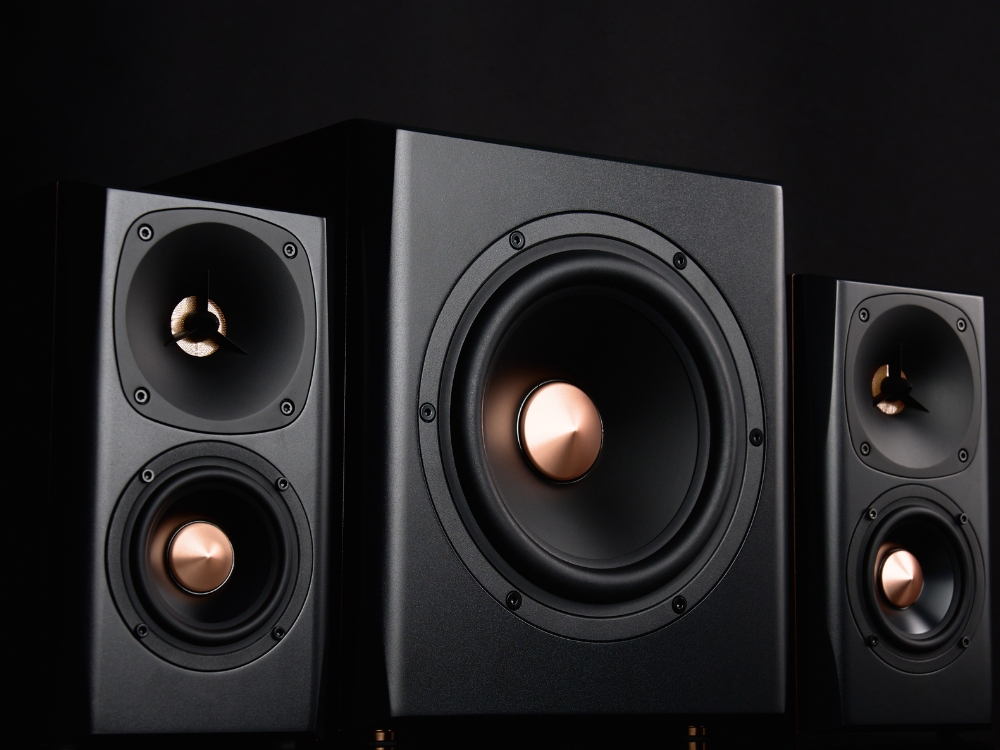Affiliate Disclaimer
As an Amazon Associate, we earn from qualifying purchases.
If you’re a music producer, sound engineer, or recording artist, you know how crucial it is to have accurate and reliable studio monitors. These specialized speakers play a vital role in capturing, reproducing, and analyzing audio with precision.
When it comes to choosing the right studio monitors, one common dilemma arises: should you opt for active or passive studio monitors? In this comprehensive guide, we’ll delve into the differences, benefits, and considerations for each type, helping you make an informed decision for your recording setup.
Table of Contents
ToggleActive vs Passive Studio Monitors: Understanding the Basics
Before we dive into the details, let’s establish a clear understanding of what active and passive studio monitors actually are.
Active Studio Monitors: Self-Powered Perfection
Active studio monitors, also known as powered monitors, have built-in amplifiers. This means they don’t require an external power amplifier to operate. Active monitors come as a complete package, with the amplifiers perfectly matched to the speakers. This integration ensures optimal performance and simplifies the setup process.
Passive Studio Monitors: Unleashing Amplifier Flexibility
On the other hand, passive studio monitors require an external power amplifier to function. They feature separate components—a speaker and a passive crossover—that divide the audio signal and send it to the appropriate drivers. The main advantage of passive monitors lies in their flexibility, allowing users to choose amplifiers according to their preferences and requirements.
Active Studio Monitors: Pros and Cons
Now that we have a basic understanding of active studio monitors, let’s explore their advantages and potential drawbacks.
Advantages of Active Studio Monitors
- Convenience and Simplicity: Active monitors come as a complete package, eliminating the need for separate amplifiers and crossovers. This makes setup quick and straightforward.
- Optimized Performance: The integration of amplifiers and speakers ensures optimal performance and compatibility. The amplifiers are precisely tailored to the drivers, resulting in accurate audio reproduction.
- Space Efficiency: Active monitors are compact and take up less space, making them an excellent choice for small recording studios or home setups.
- Built-in Processing Features: Many active monitors offer built-in processing features such as room correction and EQ controls, allowing for fine-tuning and customization.
Considerations for Active Studio Monitors
While active studio monitors offer numerous advantages, it’s important to consider a few factors before making a final decision:
- Higher Initial Cost: Active monitors tend to be more expensive upfront due to the inclusion of built-in amplifiers and additional features. However, they often provide a higher value in terms of convenience and performance.
- Limited Amplifier Choices: With active monitors, you’re limited to the built-in amplifiers, which may restrict your ability to experiment with different amplifier configurations.
Passive Studio Monitors: Pros and Cons
Moving on to passive studio monitors, let’s explore their unique advantages and potential downsides.
Advantages of Passive Studio Monitors
- Amplifier Flexibility: One of the key advantages of passive studio monitors is the ability to choose from a wide range of amplifiers. This flexibility allows you to select amplifiers that suit your specific preferences and budget.
- Easy Amplifier Upgrades: With passive monitors, upgrading amplifiers is a breeze. You can swap out or upgrade the amplifier without replacing the entire monitor setup, making it a cost-effective option in the long run.
Considerations for Passive Studio Monitors
While passive studio monitors offer their own set of advantages, it’s essential to consider a few factors before making a decision:
- Additional Components: Passive monitors require separate components, including amplifiers and crossovers. This increases the complexity of the setup process.
- Crossover Compatibility: Choosing the right crossover for your passive monitors is crucial. Improper matching can result in phase issues and compromised audio quality.
FAQs: Answering Your Burning Questions
Which type of studio monitor is better for beginners? For beginners, active studio monitors are often the preferred choice due to their convenience and simplicity. They offer a plug-and-play solution, ensuring ease of use and optimized performance without the need for additional components.
Can I upgrade the amplifiers in active studio monitors? Unlike passive monitors, upgrading amplifiers in active studio monitors is not a straightforward process. The built-in amplifiers are specifically designed for the included drivers, making it challenging to replace or upgrade them individually.
Do passive studio monitors require additional cables? Yes, passive studio monitors require separate cables to connect the amplifiers to the speakers. This includes speaker cables and interconnects for the audio signal.
Are active studio monitors suitable for large studios? Active studio monitors are suitable for studios of all sizes. They offer excellent performance and convenience, making them a popular choice for professional recording studios as well.
Can I mix and match different brands of passive studio monitors and amplifiers? Yes, you can mix and match different brands of passive studio monitors and amplifiers. However, it’s essential to ensure compatibility and proper power handling to achieve optimal audio quality.
Do active studio monitors consume more power? Active studio monitors typically consume more power compared to passive monitors, as they have built-in amplifiers. However, advancements in technology have led to the development of energy-efficient active monitors, reducing power consumption.
Final thoughts 💭
Making an Informed Choice
When it comes to choosing between active and passive studio monitors, it ultimately boils down to your specific requirements, preferences, and budget. Active monitors offer convenience, optimized performance, and space efficiency, making them a great option for many recording setups. On the other hand, passive monitors provide amplifier flexibility and easy upgradeability.
Consider the size of your studio, your desired level of customization, and your long-term plans for your recording setup. By carefully weighing the advantages and considerations of each type, you can make an informed decision that suits your needs.
- Experts Interviewed
- Customer Value
- Top Rated Products
Tips and Tricks for Choosing Between Active and Passive Studio Monitors💡
When it comes to choosing between active and passive studio monitors, here are some tips and tricks to help you make an informed decision:
Consider Your Budget💡: Determine your budget for studio monitors, taking into account the initial cost as well as any potential future upgrades. Active monitors tend to have a higher upfront cost, while passive monitors may require additional expenses for amplifiers and crossovers.
Evaluate Your Studio Size💡: Consider the size of your studio space. If you have a small studio or limited desk space, active monitors can be a more practical choice due to their compact size and built-in amplifiers.
Assess Your Technical Expertise💡: Think about your technical proficiency and comfort level with audio equipment. Active monitors are more beginner-friendly since they come as a complete package and require minimal setup. If you have experience with amplifiers and crossovers, you might prefer the flexibility and customization options offered by passive monitors.
Listen to Different Models💡: Visit a local music store or studio to listen to various models of both active and passive monitors. Pay attention to the sound quality, accuracy, and overall performance of each type. This hands-on experience can greatly help in making your decision.
Consider Room Correction Features💡: If you’re concerned about room acoustics and audio optimization, active monitors with built-in room correction features can be advantageous. These features help compensate for any acoustic anomalies in your studio, resulting in more accurate audio reproduction.
Think about Future Upgrades💡: If you anticipate upgrading your studio setup in the future, consider the flexibility of passive monitors. With passive monitors, you can easily swap out amplifiers or upgrade individual components without replacing the entire setup.
Research User Reviews and Recommendations💡: Read user reviews and seek recommendations from other professionals in the industry. Online forums, music production communities, and audio engineering groups can provide valuable insights and personal experiences with different monitor types.
Consult with Audio Experts💡: If you’re still unsure about which type of studio monitors to choose, don’t hesitate to consult with audio experts or professionals. They can provide guidance based on your specific needs, studio setup, and budget.
Consider Longevity and Durability💡: Assess the build quality and durability of the studio monitors you’re considering. Look for reputable brands that offer warranties and good customer support. Investing in monitors that can withstand regular use and provide longevity will save you money in the long run.
Test and Compare Before Buying💡: Whenever possible, test and compare different models of active and passive monitors in your studio environment. This will give you the most accurate representation of how they perform in your specific setup and help you make the best decision for your needs.
By considering these tips and tricks, you can narrow down your options and choose the active or passive studio monitors that are best suited to your recording setup and preferences.
Remember, the ultimate goal is to achieve accurate and reliable audio reproduction that enhances your creative process and delivers exceptional sound quality.
Enhance Your Monitoring Experience: Must-Have Accessories for Studio Monitors
Automate Your Studio Monitor Shutdowns and Save Energy
Reduce Vibrations and Improve Sound Quality
Protect Your Monitors from Vibrations and Enhance Performance
Keep Your Studio Environment Clean and Free of Dust and Allergens
Ensure Accurate and Consistent Sound Across Different Playback Systems






